During my second trip upstate in the last three weeks (and after my second Big Day in as many weekends) I was up for some relaxation Sunday, and got it with my family. Of course, for me, relaxation includes watching birds, so the Ruby-throated Hummingbirds coming to my parents’ feeders featured prominently in my relaxation plans.
If you look closely at the shot of the female above, taken about two meters from the bird, you can just make out a bit of spider silk on her beak. Ruby-throated Hummingbirds use spider silk when building their nests because it is a strong material that allows the nest to expand as the nestlings grow. Seeing as hummingbirds nest in my parents’ yard every year, I wouldn’t be the least bit surprised to learn that she is already working on her nest for the year.
In the half an hour I spent photographing the hummingbirds a total of three came to the feeders, two females and one male.
The male was extremely aggressive, driving the females away every time he noticed them feeding at what I can only assume he felt were his feeders, while the females seemed to be willing to share.
The feeder above is kind of beat up, both from age and from the abuse heaped upon it by marauding bears and squirrels. My dad has recently received some very nice new feeders but he is hesitant to put them out for fear that they will be destroyed (or he is a bit tired out from digging holes for trees, something I will be posting about soon). Anyway, the feeder above is nice for photography as it allows me to get shots like the one above with a still hummingbird, something I can’t get with the feeder in the shot below.
Nonetheless, I am pretty happy about that shot. But not as happy as I am about the one below, the only time I managed to get a picture of a hummingbird flying towards me even close to nicely focused.
Anyway, I highly recommend getting a hummingbird feeder for your backyard, that is, if you have a backyard, and, for that matter, if you live in the Americas. Though if, say, Europeans started putting some feeders up maybe they would be more likely to get some vagrants (get to it Jochen!).


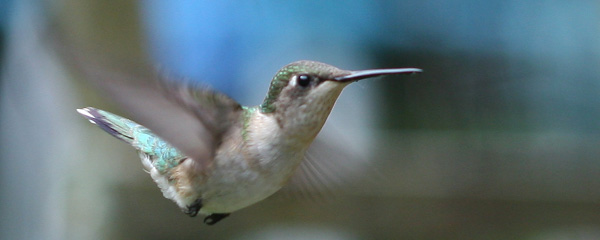
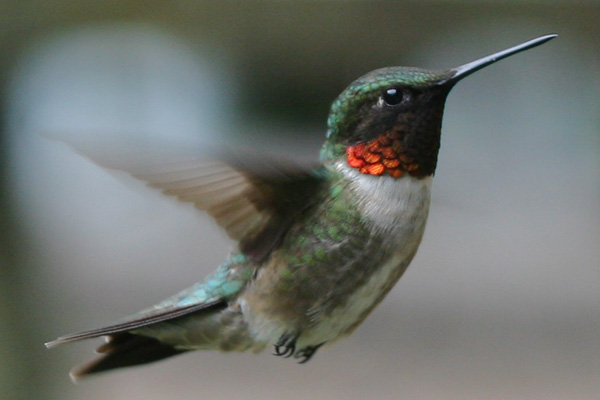
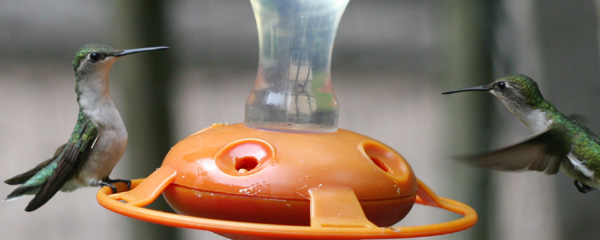
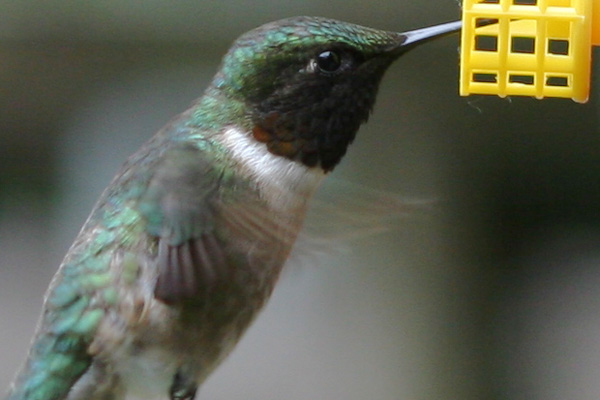
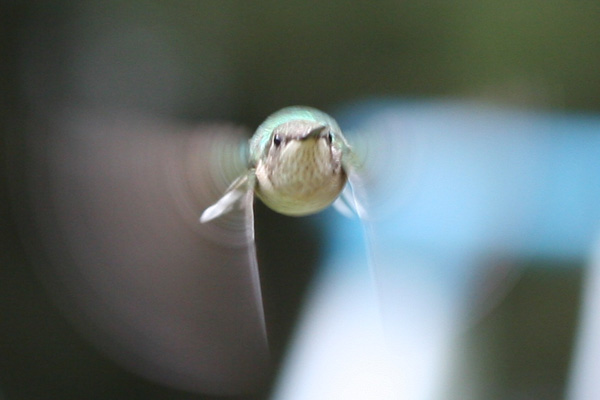











Great Photos Corey!
And as always it was a pleasure to have you in my humble city, seeing good birds and kicking the other teams butts!
Great photos, Corey!
Ruby-throated hummingbirds will nearly double their weight (from about 3.25 grams to 6 grams) before crossing the Gulf of Mexico. A single migration can become a nonstop flight of up to 500 miles over a period of 18 to 22 hours.
Male Ruby-throated Hummingbirds can also be identified by their black face and chin, and their distinctive call notes, and the lack of a wing whistle produced by their wings in flight.
Females are similar to a number of other female hummingbirds. The best way to identify the female Ruby-throated Hummingbird from the Calliope Hummingbird and species in the genus Selasphorus is by their lack of rufous on the flanks and in the tail. Anna’s Hummingbirds are larger and have grayer chests, while Costa’s Hummingbirds differ only in subtleties of facial pattern and tail pattern. Black-chinned Hummingbird females are essentially identical, and are not safely identifiable from female Ruby-throateds except in the hand. The best way to distinguish the Ruby-throated Hummingbird from all other species of hummingbirds except Black-chinned Hummingbird by their call.
The Ruby-throated Hummingbird has a total estimated population of over 7 million individuals. This species of hummingbird was hunted during the nineteenth century for its beautiful plumage, but the Ruby-throated Hummingbird now enjoys protection from harvest through the Migratory Bird Treaty Act. This act declares unlawful the taking, killing, or possessing of migratory birds. It is also listed in Appendix II of the Convention on International Trade in Endangered Species of Wild Flora and Fauna of 1975.
Well, Corey, you challenged me to comment but honestly, I first have to catch my breath and press my brain’s restart button after seeing these pics. The head-on view is unbelievable, I don’t think I have ever seen anything like it, especially as it looks as if you got it in mid-flight and not hovering in front of a feeder. Furthermore, the feeder is not visible on the top two images, which is great as I think the plastic always spoils the natural feel to hummingbird pics.
So all in all, I am sorry to say that the quality of your pics has rendered me unable to comment but then again, that may be a good thing.
That head on shot is incredible. Think about sending that into Bird and Bloom, or some other publication. Absolutely stunning.
These pictures are sooooooo amazing!! you have to burn me copies of those pics on a disc so i can frame them in the house. You know me and sean go ga-ga for humming birds!! Plus i think it’s long due for some updated pictures of your skill in photography in my house. That shot where the humming bird is coming straight at you is totally impossible!!! Can’t believe you captured that. I must say i am VERY impressed. The humming bird with the ruby throat is my favorite humming bird pic!
Thanks everyone! That was high praise indeed, Jochen. And it was fun getting so many birds on Saturday, Will.
Oh, and Steph, I might make you a print or two but they will cost you. 🙂
The most perfect hummingbird photos! Bravo
I had not known about the importance of spider webs to the hummingbird nests till I read an article from the Arizona-Sonora Desert Museum regarding problems they had when, in 1992, they renovated their hummingbird aviary by cleaning it, replanting, enlarging, etc. In the absence of spider webs, the nesting hummingbirds’ nests began to fall apart. When they realized what the problem was, they re-introduced spiders to the aviary and within days of the spiders weaving webs, they saw improvement in the state of the birds’ nests.
You have incredible photos of the hummers. Thank you for posting.
i have had many hummingbirds at my feeder for a few years now. i am very puzzled though. can anyone tell me why i very rarely see the male hummingbird and only the females? i think i saw the male once the whole summer.
@Carol: It might be that a female is nesting near you so she is a frequent visitor…also, in their first year young male hummingbirds look like females, so you might have males and not know it! At my parents’ and aunt and uncle’s feeders I tend to see at least two female hummingbirds to every one male.
thanks corey, that was a big help. so the males arent near the nesting sites?
So far as I understand it the male’s responsibility ends with fertilization. Talk about deadbeat dads…
Wow, Corey! You really ARE a big help to other people’s questions! You have studied birds a lot huh? Thanks for teaching me, I am doing a report on them. Now I know everything I need to! Your awesome!
There’s a little hummingbird that seems to live in my backyard and flies around all the time. It’s so pretty!
I have always loved Hummingbirds. I have collected all kind from wood carved, glass blown, etc. It’s always a pleasure to come across such beautiful photograghy. Excellent job!
Omg! Those r lik the bst pics i hav evr cn of humng brds i LOV thos pics espishiale the 1 that is flying towards us!
I love all of the photos but am particularly fond of the head-on shot. Thank you.
Thanks for sharing these beautiful shots! My one feeder has around 12 porst on which the Hummers can eat; however, one feeds then sits on a tree limb and chases the others away. Even my females do this. Queen Guinevere and Morgan le Fey await one another, eat together for perhaps 30 seconds then fight each other to the ground. Is this common?
My males, Rufous, King Arthur and Lancelot won’t tolerate one another. Should I purchase another feeder?
Again, thanks for these wonderful shots! ~ Janet
I have had over a hundred hummers at one time
in the summer, using 10 one qt. feeders going.
But suddenly I have an extremely aggressive
bully ruby throat hummer who is guarding the
whole 10 feeders scattered thru out the property.
He has even nearly kill one hummer who laid
injured. So I took all feeders down for 3 days and
he still sits on a tree near by protecting the garden.
What can I do? No hummers even fly near now.
Luci
I am confused about spider webs in the use
of making nests by the hummers. My friend
found a hummer who could not fly and starving
because the hummer was imbedded in spider
webs. She was able to pick all the webbing off
little by little so the hummer could fly, she even
feed the hummer nectar with some kind of devise
so she could have strength to fly. So I took down
all webs in the garden as I saw them. Am i right
or wrong doing this. thanks, luci